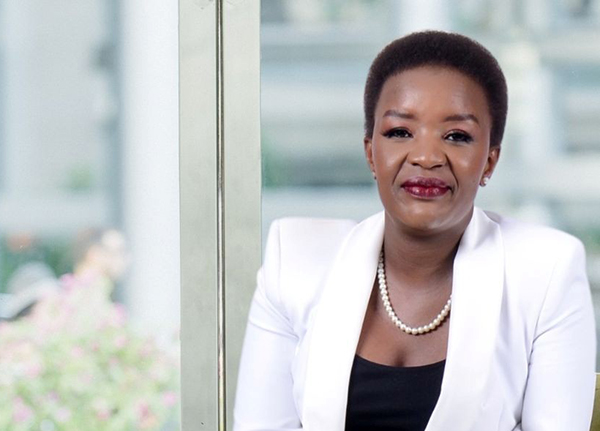The US is the fastest-growing region for South Africa’s vehicle exports and the Trump administration’s tariffs will have a significant impact on particular models that are exported there. CEO of Business Leadership South Africa (BLSA), Busisiwe Mavuso, emphasises in her weekly newsletter of 22 April, the urgency for the country to act now to forestall the impact of US tariffs on SA’s industrial base and, by implication, the wider economy.

Busisiwe Mavuso, CEO of Business Leadership South Africa.
South Africa’s automotive industry is central to the economy. Mavuso highlights that it is responsible for 60% of the country’s manufactured goods exports and is the single largest domestic manufacturing sector.
Recognising that the automotive sector was facing challenges even before the Trump administration’s tariff policies, with increased competition from imports and weak domestic demand, she says the tariffs are a further blow. Vehicle exports to the US have benefitted from the African Growth and Opportunity Act (Agoa), which has allowed duty-free access to the US market. Now, the sector is facing a 25% tariff on foreign-made vehicles and components, plus the 30% tariff on South African imports that was suspended for 90 days.
Of the vehicles exported from SA last year, 6.5% were destined for the US market, but Mavuso notes that the number had grown 22% from the year before, making the US the fastest-growing region for South Africa’s vehicle exports. Linked to the particular models that are exported to US, the tariffs will impact severely on the factories and towns where they are produced. The ripple effects will cascade throughout the respective value chains.
Of course, South Africa is one among many other countries facing US tariffs, but Mavuso emphasises that the country must act to counter the impact on the industrial economy.
She suggests the first step should be to try to engage US leaders to shift course. “US foreign policy, through Agoa, has long reflected an understanding of the strategic importance of growing Africa’s economies and building them as source markets for US consumers.” Although South African vehicles constitute only 0.1% of those sold in the US, Mavuso makes the point that this, nonetheless, helps diversify exposure to Chinese manufacturing which is an increasingly important priority for the US government. She adds that, “By ensuring the US is an important market for South Africa’s products, the US ensures it is a strategic priority for the SA government. If the US were closed to SA goods, South Africa’s wider geopolitical interests would shift to other strategic relationships, to the cost of US influence.” The Trump administration has, reportedly, said it wants to negotiate. “We must take it up and aim to clear trade barriers for the benefit of both our economies,” Mavuso says.
The second step, she suggests, is to reassess the South African Automotive Industry Masterplan (SAAM35) tabled in 2018. This provides a roadmap for the industry to 2035 and focuses on building African markets as well as diversifying into electric vehicles. The plan needs to be revisited, to assess how it can cope with the US tariffs and ensure it is geared for the world in which we now find ourselves. Mavuso highlights, for instance, that the plan’s ambitious targets – growing the industry by 60%, increasing local content and significantly increasing employment – were set before the current global context emerged.
She indicates the importance now of focusing on the rest of Africa and ensuring the African Continental Free Trade Agreement is fully implemented for vehicles. The continent buys 1.3-million new vehicles a year, a figure which is likely to grow significantly. Mavuso also suggests that the manufacturing focus in South Africa should be on brands and vehicle types that are suited for the continent, which has much to gain from lower-cost mobility solutions. We need to consider supply chains and skilling systems accordingly.
“The plan already envisages South Africa as a manufacturing hub for the continent but such long-term plans need to be dynamic and adapt to the changing environment. In addition to the US tariffs, Europe’s Carbon Border Adjustment Mechanism poses a further challenge for SA-manufactured vehicles despite it being the biggest market for our vehicle exports. However,” she says, “the EU must also deal with American trade shocks which could provide new opportunities for our exports. Other world markets will also be looking to forge new deals.”
Mavuso states that business clearly recognises the importance of the vehicle manufacturing sector. It has critical spillover effects into the rest of the economy, supporting industrial capacity that enables many other producers. It is a major employer and export revenue earner. She also notes that within a general theme of deindustrialisation over the past three decades, the automotive manufacturing industry has proven to be a singular exception. It is also, she says, a fine example of how business and government can work together to develop industry.
The first Motor Industry Development Plan, launched in 1995 transformed the vehicle manufacturing industry from a domestic producer to an export-oriented manufacturing powerhouse. It stands out as an example of how export-oriented industrial policy can work.
For more information visit: www.blsa.org.za







